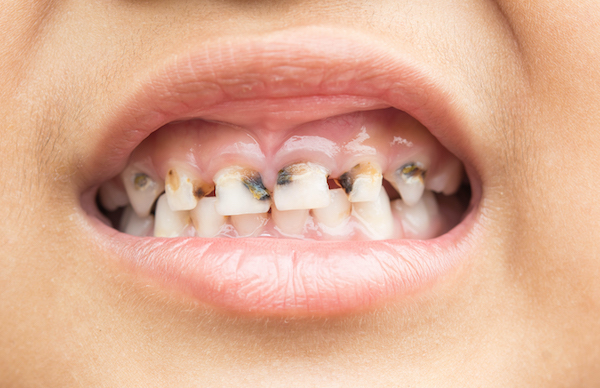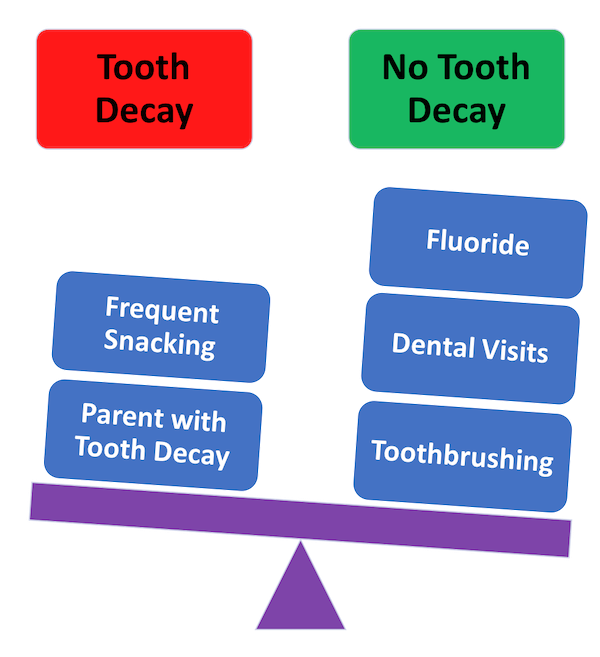 Tooth decay is caused by bacteria in the mouth that use sugar in food to make acid. Acid removes minerals from the outer tooth surface (enamel). Over time, acid breaks down the tooth surface and creates a cavity (hole) in the tooth.
Tooth decay is caused by bacteria in the mouth that use sugar in food to make acid. Acid removes minerals from the outer tooth surface (enamel). Over time, acid breaks down the tooth surface and creates a cavity (hole) in the tooth.
This Brush Up on Oral Health tip sheet explains why it is important to lower factors that can cause tooth decay and increase factors that protect teeth from decay. Head Start staff can share this information with parents.
Factors That Cause Tooth Decay
- Parent has untreated tooth decay. Parents with untreated tooth decay have high amounts of bacteria that can cause decay. Parents can pass these bacteria to their child through saliva-sharing activities. Examples of these activities are cleaning a pacifier by mouth and giving it to their child and sharing forks or spoons.
- Child has frequent between-meal snacks or drinks that contain sugar. When children snack on foods containing natural or added sugar often throughout the day, their teeth are bathed in acid for long periods of time. This gives acid more time to break tooth surfaces down and create tooth decay than it would if the child ate regularly scheduled meals and snacks.
- Child is put to bed with a bottle with liquids that contain natural or added sugar. When children are put to bed with a bottle or sippy cup containing breast milk, infant formula, or any liquid with natural or added sugar, their teeth are bathed in acid for long periods of time. The acid has more time to break tooth surfaces down and create tooth decay.
- Child has dental plaque on teeth. Dental plaque is a film on the surface of the tooth that is a mix of saliva, food, and the bacteria that cause tooth decay. If dental plaque is not removed by brushing with fluoride toothpaste twice a day, it increases the child’s risk for developing decay.
- Child has a medical condition or a disability. Children with medical conditions, such as asthma, may take medicines that contain sugar or make their mouths dry. Children with disabilities may have oral habits that can wear or break teeth, or they may eat soft foods that can lead to more dental plaque on teeth, or they may be physically unable to clean their teeth well.
- Child has had tooth decay in the past. Once children have had tooth decay, their risk for developing more tooth decay increases. This is true even for children who have had fillings.
- Child has early signs of tooth decay. Chalky white spots along the gum line of the upper teeth are the beginning of tooth decay.
Factors That Protect Teeth from Tooth Decay
In addition to lowering the factors that can cause tooth decay, it is important to increase the factors that protect teeth from decay. These include:

- Child receives fluoride. Fluoride puts minerals back into teeth that acid has removed. It also prevents the bacteria that cause tooth decay from growing. Three main ways children can receive fluoride to help protect against tooth decay are:
- Fluoridated water. Fluoride is added to many community water supplies. Fluoride can be consumed by drinking tap water and eating foods made with tap water.
- Fluoride toothpaste. As soon as the first tooth comes in, parents should brush their child’s teeth with fluoride toothpaste twice a day.
- Fluoride treatments. Staff in medical and dental offices and clinics can put fluoride varnish on a child’s teeth as soon as the first tooth comes into the mouth and then every few months afterward
- Child has a regular source of oral health care. Children who have regular dental visits are checked regularly for early signs of tooth decay. Services to protect teeth from tooth decay and repair early stages of tooth decay are also provided.
Keeping the Factors in Balance
The key to preventing tooth decay is keeping a balance between the factors that cause tooth decay and the factors that protect against decay. The goal is to lower the factors that cause decay as much as possible and increase the factors that prevent tooth decay as much possible.
Download a PDF version to print and share.
Read more:
Resource Type: Article
National Centers: Health, Behavioral Health, and Safety
Audience: Teachers and Caregivers
Series: Brush Up on Oral Health (BUOH)
Last Updated: April 25, 2023
